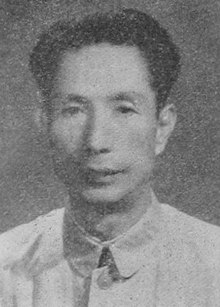Chu Tunan
Chu Tu'nan | |
|---|---|
 Chu in 1949 | |
| Vice Chairman of the Standing Committee of the National People's Congress | |
| In office 12 April 1986 – 8 April 1988 | |
| Chairman | Peng Zhen |
| Chairman of the China Democratic League | |
| In office 1986 – January 1987 | |
| Preceded by | Hu Yuzhi |
| Succeeded by | Fei Xiaotong |
| Personal details | |
| Born | 18 August 1899 Wenshan City, Yunnan |
| Died | 11 April 1994 (aged 94) |
| Political party | China Democratic League |
| Alma mater | Beijing Normal University |
Chu Tu'nan (simplified Chinese:
Biography
[edit]In 1913, he was admitted to the Union High School in Kunming, and in 1919, he was admitted to the History and Geography Department of the Beijing Higher Normal School (later Beijing Normal University), where he joined the Chinese Socialist Youth League and edited and published the newspaper Labor Culture under the guidance of Li Dazhao.[3] After graduating in 1920, he returned to Yunnan to teach in a series of high schools and organized a "reading club" among students sympathetic to the Communist Party. In 1926, Li Dazhao informed him that he would go to Northeast China to work for the CPC as a teacher, and in the winter of 1926, he officially became a member of the CPC.[4][5]
He was arrested and imprisoned from 1930 to 1934 for his involvement in the Jilin School Tide. After his release from prison, he assumed the pseudonym Chu Zeng (Chinese:

After the establishment of the People's Republic of China, he served as the president of the Chinese People's Association for Friendship with Foreign Countries.[7] In 1954, the Chinese Historical Society announced the list of its first board of governors, with Guo Moruo as president, Wu Yuzhang and Fan Wenlan as vice-presidents, and him as a councilor.[8] He was elected as a member of the Standing Committee of the Central Committee of the CNDL in 1956, and was elected as a vice-chairman of the Central Committee in 1958. During the Cultural Revolution, Chu Tunan was sent down in Minggang, Henan Province, until he was allowed to return to Beijing in 1971. [9]
He was twice elected vice-chairman of the Central Committee of the NLD, in 1979 and 1983, and in 1986 he became Acting Chairman and Chairman of the Central Committee. He also served for a long time as a delegate to the National People's Congress and a member of the Standing Committee of the Chinese People's Political Consultative Conference (CPPCC), and in April 1986 he was elected vice-chairman of the Standing Committee of the Sixth National People's Congress.[10]
He died on April 11, 1994, at the age of 95 in Beijing.[11]
References
[edit]- ^
何 虎 生 ;李 耀东;向 常 福 ; et al., eds. (2003). zh:《中 华人民 共和 国 职官志 》 (in Chinese). Beijing:中国 社会 出版 社 . ISBN 9787800883934. - ^ 廖盖
隆 ; et al., eds. (1990). 《中 囯人名 大 辞典 》 (in Chinese). Vol. 现任党 政 军领导人物 卷 . Shanghai:上海 辞 书出版 社 . - ^
李 大 钊年谱 (in Chinese).甘 肃人民 出版 社 . 1984. p. 221. Retrieved 2024-07-22. - ^
楚 图南年 谱.民 盟 历史文献 :年 谱系列 (in Chinese).群 言 出版 社 . 2008. p. 6. ISBN 978-7-80080-894-4. Retrieved 2024-07-22. - ^
中共 党 史 人物 硏究 会 (1980).中共 党 史 人物 传.中共 党 史 人物 传 (in Chinese). 陕西人民 出版 社 . p. 227. Retrieved 2024-07-22. - ^ 《
楚 图南文 选》编辑组 (1993).楚 图南文 选 (in Chinese).中共 党 史 出版 社 . p. 331. ISBN 978-7-80023-562-7. Retrieved 2024-07-22. - ^ 《统一战线
人物 志 》编写组 (2007). 统一战线人物 志 . 统一战线人物 志 (in Chinese). 华文出版 社 . p. 530. ISBN 978-7-5075-1930-3. Retrieved 2024-07-22. - ^
新 华社《中国 政府 机 构名录》编辑部 (1992).中国 政府 机 构名录, 1992/93:中央 卷 .中国 政府 机 构名录, 1992/93:地方 卷 .中央 卷 (in Chinese).新 华出版 社 . p. 789. ISBN 978-7-5011-1705-5. Retrieved 2024-07-22. - ^
中共 党 史 人物 硏究 会 (1980).中共 党 史 人物 传.中共 党 史 人物 传 (in Chinese). 陕西人民 出版 社 . p. 267. Retrieved 2024-07-22. - ^
楚 图南年 谱.民 盟 历史文献 :年 谱系列 (in Chinese).群 言 出版 社 . 2008. p. 122. ISBN 978-7-80080-894-4. Retrieved 2024-07-22. - ^ "
楚 圖 南 ".中國 政府 網 _中央 人民 政府 門戶 網 站 (in Chinese). Retrieved 2024-07-22.
- 1899 births
- 1994 deaths
- Chairpersons of the China Democratic League
- Delegates to the 1st National People's Congress
- Delegates to the 2nd National People's Congress
- Delegates to the 3rd National People's Congress
- Delegates to the 4th National People's Congress
- Delegates to the 5th National People's Congress
- Vice Chairpersons of the National People's Congress
- Beijing Normal University alumni
